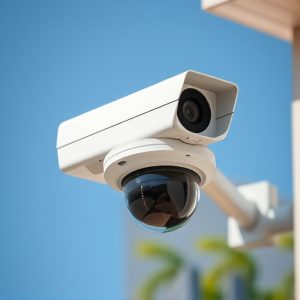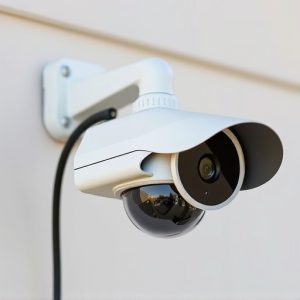Solar Powered Dummy Cameras: Installation, Benefits, and Maintenance Guide
Solar-powered dummy cameras offer an eco-friendly, convenient, and cost-effective security solution…….
Solar-powered dummy cameras offer an eco-friendly, convenient, and cost-effective security solution for homes and businesses. With easy installation, these cameras require no traditional power sources or complex wiring, merely sunlight to charge their rechargeable batteries. They are ideal for DIY enthusiasts seeking a simple yet effective security measure, but proper local regulations, strategic placement, regular cleaning, and battery maintenance are crucial for optimal performance and deterrence against intruders.
“Uncover the power of Solar-Powered Dummy Cameras, an innovative security solution that combines sleek design with advanced technology. This article explores the multifaceted benefits of these battery-operated cameras, offering a comprehensive guide to their installation, legal placement practices, and maintenance tips for maximum longevity. Learn how these unassuming devices can transform your home or business security while adhering to essential legal considerations. Discover the step-by-step installation process and unlock the secrets to maintaining their effectiveness.”
- Understanding Solar-Powered Dummy Cameras: Unveiling the Benefits
- The Installation Process: A Step-by-Step Guide
- Legal Considerations and Best Practices for Placement
- Maintenance and Longevity: Ensuring Your Fake Camera's Lifespan
Understanding Solar-Powered Dummy Cameras: Unveiling the Benefits
Solar-powered dummy cameras, also known as solar security cameras, are an innovative and environmentally friendly option for home or business owners looking to enhance their security. These cameras utilize energy from sunlight, stored in rechargeable batteries, to operate without relying on traditional power sources. This makes them highly convenient and cost-effective, especially in remote areas with limited electricity access. The installation process is straightforward; they can be easily mounted outdoors, utilizing the sun’s rays for power and capturing clear images or videos.
One of the key benefits is their sustainability. Unlike conventional cameras that require a constant power supply, solar-powered models are independent and can continue functioning even during power outages. This feature offers added peace of mind and ensures continuous surveillance. Moreover, with no need for complex wiring, installation is swift and less disruptive, making these cameras an attractive choice for those seeking a simple, effective security solution.
The Installation Process: A Step-by-Step Guide
Installing a solar-powered dummy camera is a straightforward process, ideal for those seeking an easy DIY security solution. Here’s a step-by-step guide to get you started:
1. Locate an Ideal Spot: Choose a sunny location for optimal charging. Mount the camera on a pole or wall, ensuring it’s visible and accessible to deter potential intruders. Ensure the placement allows for clear visibility of the area you wish to monitor.
2. Prepare the Base: If using a pole, dig a hole and insert the pole securely. For wall mounting, attach the bracket provided according to the manufacturer’s instructions. This step ensures stability, crucial for withstanding outdoor elements.
3. Connect Solar Panel: Attach the solar panel to the camera’s base or body. Align the panel facing the sun for maximum energy absorption. Ensure the connection is secure, allowing the panel to tilt and rotate for versatile positioning.
4. Power Up and Test: Once installed, turn on the device. Check that both the solar panel and camera function correctly, capturing clear footage and saving recordings as intended.
5. Adjust Settings (if applicable): Depending on your model, adjust sensitivity settings, motion detection zones, and recording preferences to tailor the camera to your specific security needs.
Legal Considerations and Best Practices for Placement
When considering a Solar Powered Dummy Camera Installation, legalities and best practices for placement should be at the forefront. It’s crucial to understand local laws regarding surveillance equipment. Some regions have strict rules about the visibility of cameras, consent requirements, and where they can be placed. For instance, certain areas mandate that security cameras be clearly marked as such, while others may restrict their use in private residences without explicit permission from neighbors.
Best practices suggest strategically placing these fake security cameras in obvious locations, like windows or outdoors, to deter potential intruders. They should be securely mounted and positioned high enough to capture clear footage. While they don’t record real-time video, their presence can still act as a powerful deterrent. Regularly checking and maintaining the cameras is essential; ensuring solar panels are clean and unobstructed for optimal charging, and replacing batteries when needed, helps keep them operational and effective.
Maintenance and Longevity: Ensuring Your Fake Camera's Lifespan
Battery-operated fake security cameras, often solar-powered dummy cameras, offer a convenient and cost-effective way to enhance home security. However, like any device, proper maintenance is key to ensuring their longevity. Regular cleaning of the camera and its solar panel is essential, especially in areas prone to dust or debris accumulation. This simple step goes a long way in maintaining optimal performance.
To maximize the lifespan of your solar-powered dummy camera, consider periodic checks and adjustments. Ensure the solar panel is positioned to receive direct sunlight for efficient charging. Additionally, keep an eye on any signs of damage or malfunction, addressing them promptly. Regular maintenance will not only extend the camera’s operational life but also ensure it remains an effective deterrent against potential intruders.
Solar-powered dummy cameras offer a cost-effective and eco-friendly security solution. By understanding their benefits, following a simple installation process, adhering to legal best practices, and implementing proper maintenance, you can maximize the lifespan of these devices. Remember, while they mimic real surveillance equipment, placement should be strategic for optimal deterrence and legal protection.


